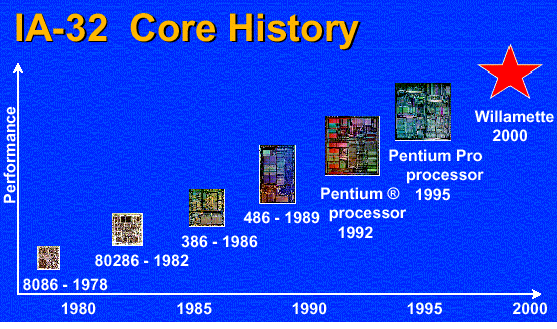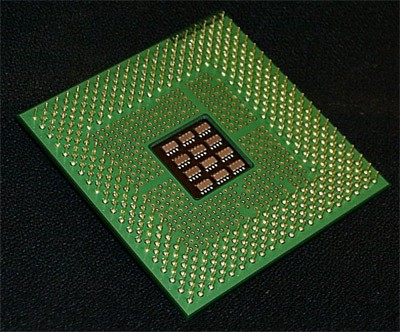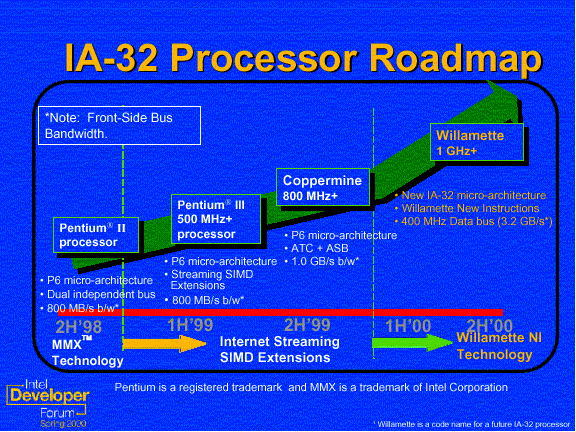
Original Link: https://www.anandtech.com/show/482
Intel IDF Report #1 - CPUs
by Anand Lal Shimpi on February 15, 2000 2:29 PM EST- Posted in
- Trade Shows
 Just
two hours into the first day of the Intel Developer Forum Intel has already
demonstrated and announced more than we have seen from them in the past few
months, and for the first time in quite a while, they’ve showed us more than
just a higher clock speed CPU.
Just
two hours into the first day of the Intel Developer Forum Intel has already
demonstrated and announced more than we have seen from them in the past few
months, and for the first time in quite a while, they’ve showed us more than
just a higher clock speed CPU.
While there has been very little discussion about chipsets other than throwing out a few names such as Solano, Solano 2, and Camino 2, the main focus of the speeches by Andy Grove and Senior VP Albert Yu has been the upcoming IA-32 architecture found in the Willamette processor and of course Intel’s flagship server platform, the Itanium. For most AnandTech readers, the Willamette is a bigger concern than the Itanium if for any reason at all, because of cost.

Willamette
The Willamette Albert Yu was demonstrating during his address ran at a core clock speed of 1500MHz, or 1.5GHz. According to Mr. Yu, this 1.5GHz chip is a member of the first run of Intel silicon for the Willamette processor and he expects to see clock speeds in excess of this initial 1.5GHz mark.

So what exactly does the Willamette offer over the Pentium III? While we will be offering a more in-depth analysis of what the Willamette brings to the desktop in our upcoming IDF summary article, in order to tide you all over we will be taking a quick look at the architecture of the Willamette.
The Willamette will begin shipping in hundred thousand quantities towards the end of this year, at clock speeds estimated above 1.5GHz. That estimation comes from the aforementioned demonstration at 1.5GHz and the statement that we should expect some higher clock speeds as the manufacturing process matures.
The CPU itself is still a 0.18-micron product and still uses Aluminum interconnects, this is in contrast to AMD’s recent demonstration of a 1.1GHz Thunderbird using Copper interconnects. According to Intel, Copper interconnects will be used in all chips towards the end of 2001 however for now they’re sticking to Aluminum. The fact that they’re using Aluminum is obviously not holding back their clock speeds courtesy of the 1.5GHz demonstration we keep on mentioning.
As a CPU, the Willamette features a few unique features that we haven’t seen from Intel in the past. The Willamette will be the first Intel CPU to feature their Streaming SIMD Extensions 2, or SSE2 that is an improvement over the original SSE instructions in their ability to handle 128-bit SIMD-Int and double precision 64-bit SIMD-FP instructions. The latter is a feature that is geared towards the professional environment however it should be interesting to see how SSE2 affects the overall performance of the CPU. We have already seen that SSE can improve performance considerably on Pentium III systems, case in point being video card drivers that take advantage of the SIMD-FP instructions as well as application specific benchmarks that illustrate a huge improvement in performance when SSE instructions are taken advantage of. The SSE2 instructions are a total of 144 new instructions that will be featured on the Willamette.
One of the biggest features of the Willamette is its ability to run the Integer ALU (Arithmetic Logic Unit) at twice the clock speed of the CPU. This means that on a 1.5GHz Willamette, the Integer ALU is actually running at 3.0GHz. For games this won’t increase performance by a large amount due to their largely floating point oriented performance dependency however in business applications and other applications that are primarily integer performance dependent the Willamette will truly excel.
The Willamette is going to be using a new bus which in protocol format is similar to the P6 bus, but the major advantage is its increased data transfer rate. Intel indicated that the bus would be operating at 400MHz, however this figure is most likely similar to the Athlon’s “200MHz” EV6 bus in that the bus actually operates at 100MHz but transfers data on both the rising and falling edges of the clock using a technology known to us by the familiar name of DDR. In the case of the Willamette, the bus will probably operate at 100MHz DDR while fetching twice as much data on the rising and falling edges of the clock. The other possibility is that the bus actually operates at 200MHz but it seems more logical for the FSB to run at 100MHz especially when you consider their recent announcement for a Quad Pumped Bus.

We were just recently informed that the chipset used for the Willamette will be the Tahema and it will be RDRAM-only. While this may definitely turn some users off of the Willamette, according to our sources, by the time that the Willamette hits the streets we should expect RDRAM to be much cheaper. Whether or not this wish will come true has yet to be seen, only time will tell.
The demo Intel showed consisted of little more than showing a 1.5GHz Willamette running their Frequency ID Utility which was extremely disappointing since they failed to even run any commonplace benchmarks on the system. We’ve been sitting here with a member of the Tom’s Hardware crew and we’ve been discussing the reasons behind Intel not even running any benchmarks on the setup, the main conclusion we’ve come to is that because of the nature of the CPU as a first revision silicon product it probably couldn’t run anything more than the frequency ID utility without sacrificing stability. Chances are that they didn’t want to demonstrate a 1.5GHz chip that would crash upon entering Winstone or SYSMark. If anything, they just wanted to show that they are on top of the clock speed battle, especially with AMD just recently shipping the 850MHz parts and their demonstration of a 1.1GHz Thunderbird.
We’ll have more Willamette information as the conference goes on.
Timna
Another interesting topic of discussion, although not as big as Willamette, is the Timna. The Timna is the first chip that boasts a technology Intel coined as Smart Integration. The Timna will be Intel’s sub-$600 flagship CPU made possible because of this Smart Integration technology.
Smart Integration essentially takes the memory controller and the graphics controller and moves them off of the motherboard and actually integrates them onto the CPU. This will definitely be a poor gaming solution compared to the dedicated 3D graphics accelerator solutions that will be available around the release of the Timna, but for the entry level market the Timna should be quite successful.
According to Intel, the Timna’s integrated graphics should be an extension of the i752 graphics core, and not an entirely new design.
As a notebook solution, if it ever makes it into that market, the Timna should also be an interesting solution.
Chipsets
One of the biggest discussions in recent times has been over the exclusive support of RDRAM as a memory solution on the i820 chipset.
From what we’ve been able to gather, Intel is definitely going to be using DDR SDRAM in the server platforms and they’ve stated that RDRAM isn’t a solution for the value segment, however what they have not stated is that it will be used in the performance value segment. This means that most performance desktops won’t be using DDR SDRAM, leaving RDRAM as a continually supported option from Intel.
According to Intel, as the processor performance increases, the benefits experienced from RDRAM will increase as well. The figures they gave us now indicate a 2 – 5% benefit from RDRAM now, and they predict that as the performance of CPUs increase that figure could increase to 30%. They don’t see a role for DDR SDRAM in the desktop market, which is very unfortunate, at least for the time being.
Another interesting thing to note is that they indicate that RDRAM will be an option in the value segment in the next 1 – 2 years. It sounds like Intel definitely has strong beliefs in RDRAM, in spite of the recent flak they’ve been given for supporting the expensive memory standard. The next year should be very interesting to say the least.
ConclusionWhile the forum has definitely gotten off to a very interesting start, this is only the first day and there is quite a bit to come. Be sure to check back during the next couple of days for even more first hand updates from IDF as well as nightly summaries of everything that’s going on over here in sunny Palm Springs.







